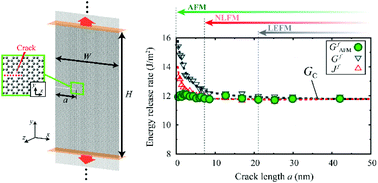Beyond conventional nonlinear fracture mechanics in graphene nanoribbons†
Abstract
Owing to a finite and single-atom-thick two-dimensional structure, graphene nanostructures such as nanoribbons possess outstanding physical properties and unique size-dependent characteristics due to nanoscale defects, especially for mechanical properties. Graphene nanostructures characteristically exhibit strong nonlinearity in deformation and the defect brings about an extremely localized singular stress field of only a few nanometers, which might lead to unique fracture properties. Fundamental understanding of their fracture properties and criteria is, however, seriously underdeveloped and limited to the level of continuum mechanics and linear elasticity. Here, we demonstrate the breakdown of continuum-based fracture criteria for graphene nanoribbons due to the strong nonlinearity and discreteness of atoms emerging with decreasing size and identify the critical sizes for these conventional criteria. We further propose an energy-based criterion considering atomic discrete nature, and show that it can successfully describe the fracture beyond the critical sizes. The complete clarification of fracture criterion for nonlinear graphene with nanoscale singularity contributes not only to the reliable design of graphene-based nanodevices but also to the elucidation of the extreme dimensional limit in fracture mechanics.



 Please wait while we load your content...
Please wait while we load your content...